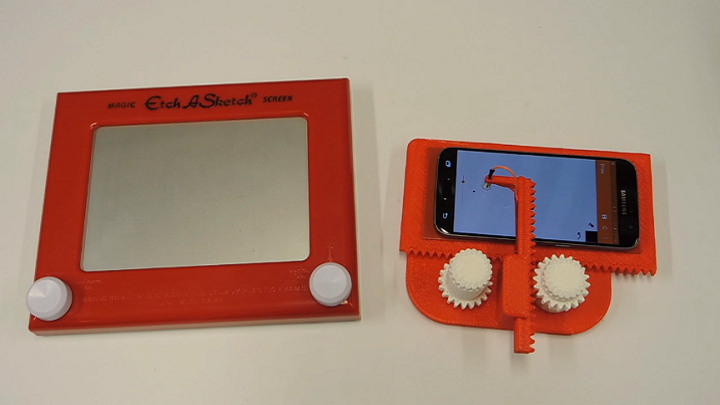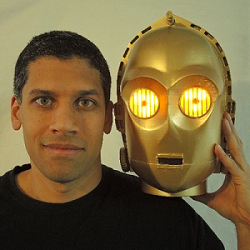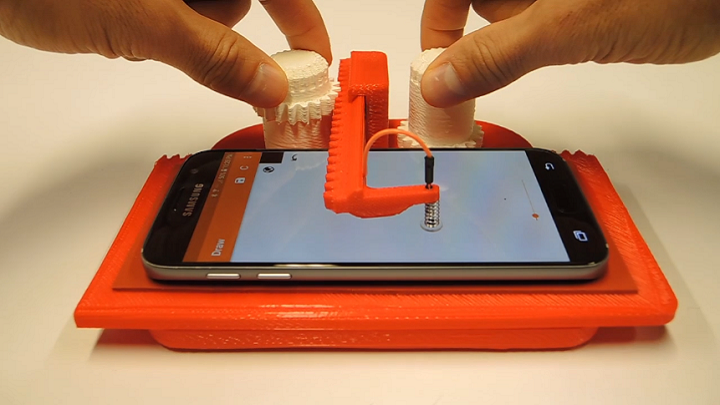If you haven’t gotten so frustrated with your terrible attempt at an Etch-a-Sketch drawing that you’ve had to resist the overwhelming urge to fling the toy across the room, have you even really lived at all? Invented in the 1950s by Andre Cassagnes, the popular red-framed drawing device uses an internal stylus, directed by those round white knobs on the bottom two corners, to move gray aluminum powder around into artwork, or at least something like it.
Like so many other classic items, the Etch-a-Sketch has received new life before through the use of 3D printing. Recently, maker Ali of the Potent Printables YouTube Channel turned to the technology to update the Etch-a-Sketch toy once again.“Thought you might be interested in something I designed- it is a 3D printed device that lets you temporarily turn your cell phone into an Etch-A-Sketch,” Ali told 3DPrint.com.
Ali recently began a new YouTube series called “Old and New,” which looks at older mechanisms and designs. Then, Ali will use 3D printing to recreate or re-imagine the item. The Etch-a-Sketch is the subject of his first episode, and Ali starts off by paying his respects to the original toy.
“Erasing the etched image is done by shaking the Etch-a-Sketch,” he explains in the video. “Remember those beads that were mixed in with the aluminum powder? Those help to smooth out and redistribute the powder across the glass, which resets the drawing area.”
Moving on to his more modern version, Ali explains that he designed the Cell Phone Etch-a-Sketch in SOLIDWORKS, and then printed it out of PLA on his LulzBot TAZ 6 3D printer. He included the STL files on both Thingiverse and MyMiniFactory for those who want to try making their own version. In addition, he’s put together a kit of all the necessary supplies for the project beyond the 3D printed parts, which is available for purchase on his Etsy shop. These supplies include:
- conductive stylus
- jumper wire
- silicone sheet
- pen springs
- JB Kwik 2-part epoxy
- wrist strap
“Please note that I found differences in touchscreens sensing the stylus, especially between Android and Apple cell phones,” Ali wrote on MyMiniFactory. “Apple devices require the stylus to be electrically tied back to the user.
“However, I haven’t done extensive testing on different Android phone manufacturers, so if you want to guarantee this will work, also buy the wrist strap.”
 Some of the benefits Ali noted from using a cell phone as an Etch-a-Sketch include adjusting the pointer size, being able to lift the stylus off of the screen to move it somewhere else, erasing selected areas, drawing in different colors, and the ability to save your sketches, which “makes making mistakes less deadly.”
Some of the benefits Ali noted from using a cell phone as an Etch-a-Sketch include adjusting the pointer size, being able to lift the stylus off of the screen to move it somewhere else, erasing selected areas, drawing in different colors, and the ability to save your sketches, which “makes making mistakes less deadly.”
Ali explains in the video how the device actually works, noting that the actual cell phone is held on a platform which moves in one direction, thanks to a rack and pinion mechanism.
“A conductive stylus is mounted in another rack and pinion mechanism, which moves in the other direction,” he explained. “This stylus is spring-loaded and can move up and down to accommodate the different heights of various phone types.”
According to Ali, his project is getting a pretty good response – the short video of the cell phone Etch-a-Sketch he posted to Twitter has already received over 8,500 views. On Reddit, the video has been viewed 32.3k times and has received 2,400 upvotes.
“There are some downsides to this current design, which are mostly due to making it as 3D printer-friendly as possible,” Ali noted in the video. “The controls are not as accurate or smooth as a classic version, and the stylus tip partially obscures the drawing area.”
In addition, a few people on Reddit took issue with the various axes on the device. User hollaverga said they’d need to modify the design to add an idler gear to invert the X axis, while crua9 suggested a third knob to provide the device with a Z axis. Super_Dork_42 said the entire thing could be entirely 3D printed if one used a conductive filament, which Ali was all for, saying that it was “a really good suggestion.” This is what’s so great about the maker community – no one’s feelings are getting hurt if another person suggests something to make a design even better than the original version.
“If you are planning on printing and building one of these, please read the assembly guide that I have included,” Ali cautioned.
“If you do print one, please share pictures with me on social media.”
Will you try and make your own Cell Phone Etch-a-Sketch? Let us know! Discuss this and other 3D printing topics at 3DPrintBoard.com or share your thoughts in the comments below.
Subscribe to Our Email Newsletter
Stay up-to-date on all the latest news from the 3D printing industry and receive information and offers from third party vendors.
You May Also Like
3D Printing News Briefs, April 13, 2024: Robotics, Orthotics, & Hypersonics
In 3D Printing News Briefs today, we’re focusing first on robotics, as Carnegie Mellon University’s new Robotics Innovation Center will house several community outreach programs, and Ugogo3D is now working...
Rail Giant Alstom Saves $15M with 3D Printing Automation Software 3D Spark
3D Spark has entered into a three-year deal with the rail giant Alstom. Alstom, a transport behemoth with annual revenues of $16 billion, specializes in the manufacture of trains, trams,...
Meltio Expands Global Reach with New Partnerships in the Americas and Europe
Spanish 3D printing manufacturer Meltio has expanded its sales network across the globe. With the addition of three new partners in the United States, Brazil, Argentina, and Italy, Meltio aims...
3D Printing Webinar and Event Roundup: April 7, 2024
Webinars and events in the 3D printing industry are picking back up this week! Sea-Air-Space is coming to Maryland, and SAE International is sponsoring a 3D Systems webinar about 3D...


































